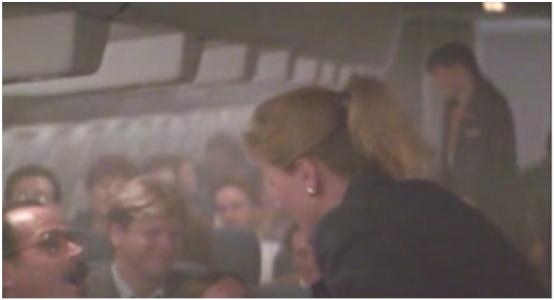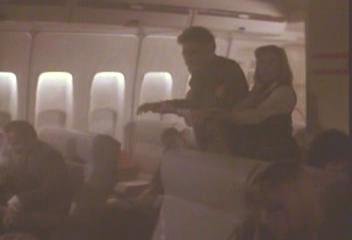En Route
(Question: Have you ever travelled by air?
What do you think of air travelling?)
Have you ever taken a trip by airplane? If not, read this article
and it will tell you about the good and courteous services on board
a plane.

The large airplane is en route to a country
which most of its passengers have never visited before. “En route” means
on the way. The passengers are the people riding in the airplane. Most
of these passengers are tourists — people who travel to see another
place, area, or country. Most tourists travel for pleasure. They enjoy
seeing different places and meeting other people.
The long flight, or trip by air, is almost
over. The passengers have finished their dinner. Most of them are resting
or relaxing — sleeping, reading, or talking. But for Miss Brown and
Mr. Green, who are going home, there are still many things to do before
their arrival.
Sue Brown is a stewardess and Sam Green is
a steward for their country’s airline (the company that operates the
airplanes). Their job is to look after the comfort and safety of the
passengers who ride in the passenger cabin of the airplane during the
flight. They are also called cabin or flight attendants.
Passenger safety is the main job of flight
attendants. Miss Brown and Mr. Green must make sure the passengers are
sitting safely. The things passengers bring on the plane with them must
be put away safely so that they will not slide around during the flight.
If the plane should move or turn suddenly, a loose object could hit
and injure someone.
Before the flight begins, the flight attendants
tell the passengers: “Please stow all hand or carry-on luggage under
the seat in front of you or in the overhead ompartments.”
The things passengers bring aboard (on) the plane
are called hand or carry-on luggage. “To stow” these means to put them
away. Carry-on luggage can fit either under the seat or in a special
compartment (enclosed space) above the seats over the heads of the passengers.
Cabin attendants must make sure these compartments are closed properly
during the flight.

En route, the cabin attendants serve food and
beverages (drinks) to the passengers. This keeps the attendants busy
and on their feet during most of the flight. On a flight of five hours
or more, Miss Brown and Mr. Green walk between 10 and 15 miles — or
16 to 24 kilometers — as part of their jobs.
Their duties also include welcoming the passengers
aboard the airliner and helping them to find their seats. A flight attendant
must show the passengers where the emergency exits are and explain how
to use the oxygen masks.
The flight attendants also give out pillows
and blankets to help make passengers comfortable. They give passengers
magazines to read. They must be able to answer questions about the times
of flights and the services of the airline.
“It’s an interesting job,” Mr. Green says,
“and we meet many interesting people. We get to see different places.
But it’s not all fun. We live out of suitcases, and we serve hundreds
of meals each day. A flight attendant has to enjoy taking care of and
serving people.”
“Even under the best conditions,” Miss Brown
adds, “taking care of a plane full of hungry, thirsty people is not
easy. But we have to stay calm and pleasant at all times. This is especially
important when bad weather makes a flight rough or bumpy, when a plane
is late, or when there is an emergency.” (Question: Can you pick out
two words from the text to describe the job of flight attendants?)
Flight attendants must learn about the safety
equipment of the airplane in which they are flying. They must know how
to get passengers out quickly and safely if there should be an accident.
And, most important, they must be able to keep the passengers calm in
an emergency.
All flight attendants must be able to give
first-aid. This is the help that is given to a sick or hurt person before
regular medical treatment from a doctor can be obtained. Such treatment
can often save a person’s life if it is given quickly. Learning to give
first-aid is an important part of a flight attendant’s training.
“A flight attendant,” Mr. Green says, “has
to be able to stay calm and courteous at all times. This is important
for the safety of the passengers.”

Miss Brown adds, “Passengers spend more time
with flight attendants than with any other airline employee. The service
the passengers receive on board the plane determines whether or not
they will fly again on one of our airplanes. We want them to continue
to be customers of our airline. So it is important that we give them
good, courteous service.” (Question: Why are good flight attendants
so important to an airline company?)
From English for the Travel Industry, McGraw-Hill Inc.,
1982.
Approximately 750 words.
|